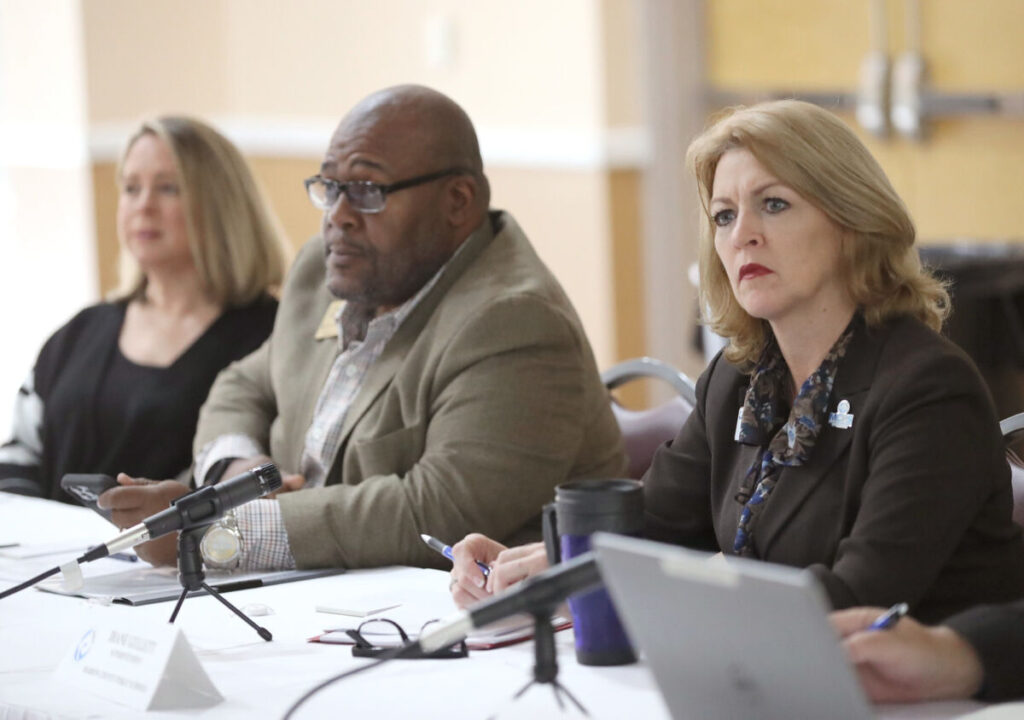District explores measures to combat school overcrowding

Diane Gullett, the Superintendent of Marion County Public Schools, right, listens to a presentation with Eric Cummings, center, and Kelly King, left, of the Marion County Public School Board during a joint workshop with the Marion County Commission at the Southeastern Livestock Pavilion auditorium in Ocala, Fla. on Monday, Nov. 8, 2021. Bruce Ackerman/Ocala Gazette] 2021.
As part of a presentation given to the school board at Thursday’s administrative work session, district staff outlined key areas of residential development that will contribute to overcrowding in schools.
Several proposals were presented to encourage both short and long-term facility planning, as well as long-term financial planning to help alleviate the stress placed on school capacity as soon as possible while preventing further overcrowding in the future.
Short-Term Facility Planning
Barbara Dobbins, executive director of operations and emergency management, outlined several ways that the district may accommodate the growing number of school-aged residents in Marion County. The most notable measures included conducting ongoing school site review and placing portable classrooms on school campuses that face the highest utilization rates.
“Since the projections for school year 2022-2023 were released, I have been in contact with principals who are being impacted by overcrowding,” Dobbins said. “Our technical services team has conducted school site reviews and is identifying potential portable placements and utility locations for those portables.”
These site reviews led school board and district members to believe that portable classrooms will continue to be the most efficient and viable solution to deal with overcrowding as a method of short-term facility planning as efforts to fund new construction continue.
“We have identified available portables that can be relocated. We are also in the process of contracting with a vendor for portable leasing, and we have increased our budget for portables in our 2022-2023 budget,” Dobbins said.
The portable classrooms will be relocated on a highest-need basis, which will be dependent on the utilization levels seen in the most recent Florida Inventory of School Houses (FISH) report and the Impact of Growth on Marion County presentation given at the administrative work session.
“At this time, we know that Liberty Middle School does not have the ability to appropriately house students for the next school year,” Dobbins said. “We are in the process of relocating three portables over the summer to Liberty Middle School so that they can be in place for the start of the school year.”
Liberty Middle School is just one of several schools in the southwest area of Marion County that is far overcapacity. The school is at 111% enrollment capacity, with 1339 students enrolled while the school only has a capacity of 1203 seats, according to the presentation.
“For all of our schools that have potential overcrowding, we are also exploring a modular building unit that would house four to six classrooms,” Dobbins said. “Meanwhile we continue ongoing communication and monitoring of the situations.”
Dobbins noted that some schools are either landlocked or lack the infrastructure to add portable units. One example Dobbins pointed to was Saddlewood Elementary, an overcapacity school that had recently become a hot topic at city council meetings when a developer proposed building more than 300 units across the street.
Long-Term Facility Planning
The maintenance needs of the schools surpass the capital outlay funding available by millions of dollars, according to Dobbins. She said that because of this, there is no available funding from the capital outlay to allocate towards the construction of new schools in the future.
“We know that we have to replace Lake Weir Middle School, which was board approved in 2018, but again we have no capital outlay funds available for new construction,” Dobbins said. “Since 2018, we have to ask if Lake Weir Middle School is our first priority now. Is the land location for the new middle school the right location?”
The board discussed cost comparisons between renovating existing schools versus building entirely new wings with 10-12 classrooms and utilities, but no definitive cost analysis could be made without specific intention to do so.
“Currently based on city and county land development, we think we need a K-8 school in the southwest area, and we know we have needs for multiple wings at numerous schools due to a large number of usage of portables currently and also a potential overcrowding,” Dobbins said.
The most crucial steps for the district to take to begin long term facility planning are for a long-term needs assessment and an impact fee analysis to be conducted respectively to create a concrete plan for how development will proceed.
“In order to make an informed decision grounded in evidence-based data, we must seek out a credentialed independent analysis that can evaluate and validate our current and future prioritized needs,” Dobbins said.
The impact fee analysis that would follow would consist of payments made by the local government to expand the public capital facilities that may benefit the funding directed towards new construction.
“To consider seeking impact fees, we again must conduct an in-depth study to validate the need for such fees,” Dobbins said. “We are currently planning for these two analyses and anticipate that these in-depth assessments will take a minimum of six months once the board approves.”
Long-Term Financial Planning
The school district may utilize funds that are already available to implement the suggested changes, as well as vote to use other sources to allocate spending, according to Chief Financial Officer Theresa Boston-Ellis.
Boston-Ellis said that the required local effort to participate in the Florida Education Finance Program, as well as agreeing to levy a required local tax, might provide the district the chance to allocate these funds towards not only maintenance and renovation, but the construction of new facilities.
“In addition to that, a school district may levy what we call a discretionary non-voted current operating millage,” Boston-Ellis said. “There are many things that you can use those funds for: new construction, remodeling, expansion of existing sites, improvement of sites and auxiliary facilities.”
These funds can also be used towards maintenance, renovations and repairs as the district sees fit. This also leaves open the option for the district to lease equipment, computer hardware and other devices, according to Boston-Ellis.
“This year, our tax base was about $24.5 billion dollars, and that generated approximately $35 million dollars for our fiscal year for capital projects,” Boston-Ellis said. “Unless we get really excited about that…we do use those dollars to pay for debt, so of that $35 million that we are projecting for next year approximately $14 million of that is already relegated to debt payments.”
The debts that the funds are already relegated to include the fee for the district’s certificate of participation, and for a lease purchase made by the district for 150 school buses.
The district formerly utilized the Public Education Capital Outlay (PECO), provided by the state, with categories of funding for both new construction and renovation. Boston-Ellis said that the district has not received PECO funds for construction for the past 11 years, and that it received $11 million dollars 11 years ago but only received sporadic funding since, and then no funding from 2019 on.
The district may utilize the sales surtax to fund schools, pending voter approval, Boston-Ellis said. The sales surtax is based off Florida Statute 212.055, and if the board levies this tax as a resolution it may appear before voters to decide whether or not the tax will be implemented to benefit schools.





